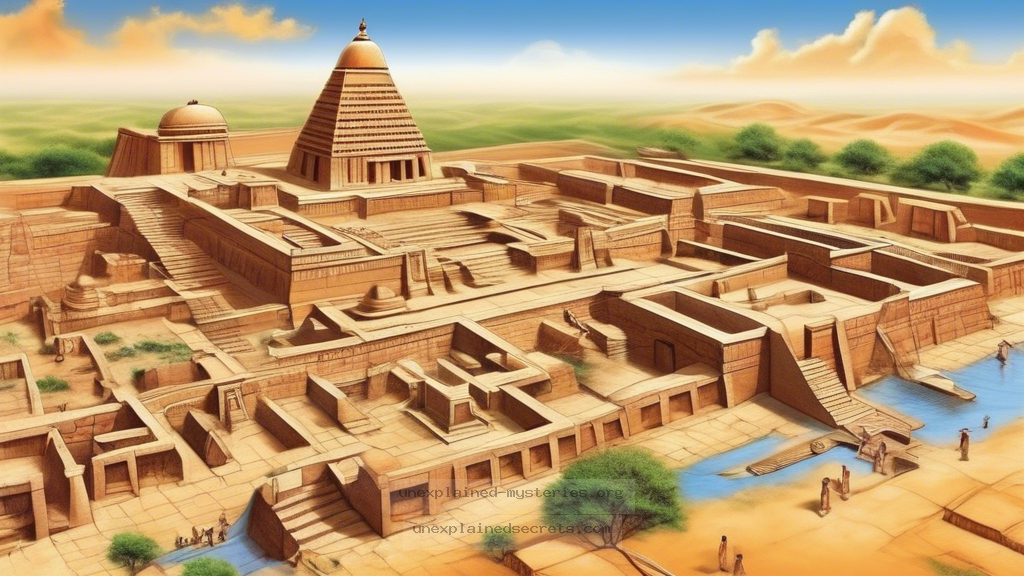What Happened to the Indus Valley Civilization’s Advanced Urban Planning and Technology?
What Happened to the Indus Valley Civilization’s Advanced Urban Planning and Technology?
The Indus Valley Civilization (IVC), one of the world’s earliest urban cultures, flourished around 3300 to 1300 BCE in what is now Pakistan and northwest India. This civilization is renowned for its remarkable urban planning, advanced drainage systems, and standardized weights and measures. Yet, despite its sophistication, the IVC mysteriously declined and eventually vanished, leaving behind a plethora of unanswered questions. This blog post explores the enigmatic disappearance of this advanced civilization, delving into its historical significance, core theories about its decline, and ongoing research to uncover the truth behind its fate.
Historical Context: The Rise of the Indus Valley Civilization
The Indus Valley Civilization emerged around 3300 BCE, with major urban centers like Harappa and Mohenjo-Daro. The cities were meticulously planned with grid layouts, advanced drainage systems, and public baths, showcasing a level of urban sophistication that rivals modern cities. Archaeological findings indicate that the IVC had a rich culture, engaging in trade with Mesopotamia and other neighboring regions, suggesting an extensive economic network.
The civilization’s population is estimated to have reached around 5 million at its peak. The people of the IVC were skilled artisans, producing intricate jewelry and pottery, while evidence suggests they engaged in agriculture, growing crops like wheat and barley. Their technological advancements were impressive for the time, featuring standardized brick sizes and sophisticated weights for trade.
Core Concepts: Urban Planning and Technological Innovations
The urban planning of the Indus Valley Civilization is one of its most compelling features. Cities were built on a grid pattern, with streets laid out at right angles, indicating a high level of organization. The drainage systems were remarkably advanced, with covered sewers and individual house connections, showcasing an understanding of sanitation and public health that was far ahead of its time.
| Feature | Details |
|---|---|
| City Layout | Grid pattern, streets aligned, efficient land use |
| Drainage System | Covered drains, connection to homes, public sanitation |
| Weights and Measures | Standardized units, evidence of trade |
The technological aspects of the IVC are equally fascinating. The civilization employed techniques in metallurgy, producing copper, bronze, and lead. They also engaged in cotton production, arguably being the first to cultivate and weave cotton fabric. Despite these advancements, the reasons for the civilization’s eventual decline remain shrouded in mystery.
Theories of Decline: Climate Change and Environmental Factors
One of the leading theories regarding the decline of the Indus Valley Civilization is climate change. Recent research suggests that the region experienced significant shifts in climate patterns, leading to prolonged droughts. This would have severely impacted agriculture, the backbone of the IVC’s economy. A study published in the journal “Nature” indicates that between 2200 and 1900 BCE, the region faced a dramatic reduction in monsoon rains, which could have led to food shortages and societal stress.
Additionally, geological surveys have revealed evidence of river shifts in the region, particularly the drying up of the Ghaggar-Hakra river system, which many believe was crucial for agriculture and trade. As the river systems changed, cities may have been abandoned, leading to a gradual decline.
Core Concepts: Invasions and Societal Collapse
Another prevalent theory posits that invasions by external groups contributed to the decline of the Indus Valley Civilization. The arrival of the Indo-Aryans around 1500 BCE may have disrupted the established social order. Archaeological evidence, including weapons and fortifications, suggests that there may have been conflicts between the IVC inhabitants and these incoming groups.
However, there is little definitive evidence to confirm large-scale invasions. Many scholars argue that societal collapse could have resulted from internal strife, possibly exacerbated by environmental changes and economic decline. This view suggests a gradual disintegration rather than a sudden invasion.
Alternative Perspectives: Trade and Economic Factors
While climate change and invasions are prominent theories, some researchers emphasize the role of trade networks in the IVC’s decline. As trade routes shifted or collapsed, it could have led to economic destabilization. The IVC was heavily reliant on trade with Mesopotamia and other regions, and any disruption in these connections could have had dire consequences.
Furthermore, the emergence of alternative trade routes and competing civilizations may have rendered the IVC less significant on the global stage. The decline of Harappa and Mohenjo-Daro might not be solely attributed to internal factors but rather to a complex interplay of economic challenges and external pressures.
Common Misconceptions: The “Mysterious” Disappearance
One of the most pervasive misconceptions about the Indus Valley Civilization is that it simply vanished without a trace. In reality, archaeological evidence indicates a gradual decline rather than an abrupt disappearance. The cities of the IVC were not abandoned overnight; rather, they experienced a decline in population and activity over centuries.
Moreover, many scholars suggest that the remnants of the IVC culture can be found in subsequent Indian civilizations. Elements of their urban planning, agriculture, and crafts persisted and evolved in later cultures, showcasing the resilience and adaptability of human societies.
Investigating the Mystery: Best Practices for Research
Understanding the fate of the Indus Valley Civilization requires a multidisciplinary approach. Archaeologists, climatologists, geologists, and historians must collaborate to piece together the puzzle of this ancient society’s decline. Here are some best practices for conducting research:
- Conduct interdisciplinary studies that incorporate various scientific methods.
- Utilize modern technology, such as satellite imagery and ground-penetrating radar, to uncover hidden archaeological sites.
- Engage with local communities to gather oral histories and traditional knowledge that may provide insights.
- Encourage collaborative efforts between international researchers to share findings and methodologies.
Future Developments: Ongoing Research and Discoveries
Research on the Indus Valley Civilization is ongoing, with new discoveries being made regularly. Recent excavations in areas like Rakhigarhi, one of the largest Harappan sites, have provided fresh insights into the society’s lifestyle, trade practices, and cultural connections. Advances in genetic studies are also shedding light on the population dynamics of the IVC, revealing connections with other ancient populations.
As climate change continues to be a pressing global issue, studying the IVC can offer valuable lessons about societal resilience and adaptation. Understanding how this civilization responded to environmental pressures may provide insights applicable to modern contexts.
Conclusion: Unraveling the Enigma of the Indus Valley Civilization
The mystery of the Indus Valley Civilization’s decline is a captivating narrative that intertwines environmental, societal, and economic factors. While theories abound, no single explanation fully accounts for the civilization’s fall. Instead, it appears to be a confluence of challenges that ultimately led to its transformation.
As we continue to study this ancient civilization, we uncover not only its historical significance but also lessons that resonate today. The Indus Valley Civilization serves as a reminder of the fragility of human societies in the face of environmental change and the importance of sustainable practices in ensuring cultural longevity.
Through ongoing research and interdisciplinary collaboration, we may one day unravel the complete story of the Indus Valley Civilization, shedding light on its remarkable achievements and the circumstances that led to its enigmatic decline.
Other Articles
Recent Posts
- What Happened to Flight MH370? The Conspiracy Theories That Still Haunt Us
- What Secrets Lurk Within the Walls of the Infamous Trans-Allegheny Lunatic Asylum?
- What Evidence Supports the Existence of Bigfoot in the Pacific Northwest?
- What Happened to the Indus Valley Civilization? Unraveling the Mysteries of Ancient Urban Life
- Can Telepathy Be Scientifically Proven Through Laboratory Evidence?







